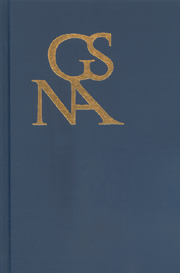Book contents
- Frontmatter
- Contents
- Towards a German Romantic Concept of the Ballad: Goethe's “Johanna Sebus” and Its Musical Interpretations by Zelter and Reichardt
- “Trübe” as the Source of New Color Formation in Goethe's Late Works Entoptische Farben (1817–20) and Chromatik (1822)
- The Myth of Otherness: Goethe on Presence
- The Transformation of the Law of Nations and the Reinvention of the Novella: Legal History and Literary Innovation from Boccaccio's Decameron to Goethe's Unterhaltungen deutscher Ausgewanderten
- “Hear him! hört ihn!”: Scholarly Lecturing in Berlin and the Popular Style of Karl Philipp Moritz
- Hypochondria, Onanism, and Reading in Goethe's Werther
- Judex! Blasphemy! and Posthumous Conversion: Schiller and (No) Religion
- Esoterik der “Macht, die über uns waltet und alles zum Besten lenkt”: Das Wissen vom Anderen in Goethes Wilhelm Meisters Lehrjahre
- Goethes Fortgepflanztes: Zur Unbegrifflichkeit der Morphologie
- Special Section on Die Entstehung der Neueren deutschen Literaturwissenschaft aus der Goethe-Philologie
- Introduction
- Goethe und Goethe-Philologie als Muster der neugermanistischen Editionswissenschaft: Eine Skizze mit Blick auf literaturwissenschaftsgeschichtliche Kontexte
- “Aus dieser fingierten Welt in eine ähnliche wirkliche versetzt”?: Die Theorie der Autobiografie und ein postmoderner Goethe
- “Man sucht einen Mittelpunkt und das ist schwer und nicht einmal gut”: Figurationen der Verdopplung in Wilhelm Meisters Lehrjahren
- Book Reviews
“Aus dieser fingierten Welt in eine ähnliche wirkliche versetzt”?: Die Theorie der Autobiografie und ein postmoderner Goethe
from Special Section on Die Entstehung der Neueren deutschen Literaturwissenschaft aus der Goethe-Philologie
Published online by Cambridge University Press: 05 February 2013
- Frontmatter
- Contents
- Towards a German Romantic Concept of the Ballad: Goethe's “Johanna Sebus” and Its Musical Interpretations by Zelter and Reichardt
- “Trübe” as the Source of New Color Formation in Goethe's Late Works Entoptische Farben (1817–20) and Chromatik (1822)
- The Myth of Otherness: Goethe on Presence
- The Transformation of the Law of Nations and the Reinvention of the Novella: Legal History and Literary Innovation from Boccaccio's Decameron to Goethe's Unterhaltungen deutscher Ausgewanderten
- “Hear him! hört ihn!”: Scholarly Lecturing in Berlin and the Popular Style of Karl Philipp Moritz
- Hypochondria, Onanism, and Reading in Goethe's Werther
- Judex! Blasphemy! and Posthumous Conversion: Schiller and (No) Religion
- Esoterik der “Macht, die über uns waltet und alles zum Besten lenkt”: Das Wissen vom Anderen in Goethes Wilhelm Meisters Lehrjahre
- Goethes Fortgepflanztes: Zur Unbegrifflichkeit der Morphologie
- Special Section on Die Entstehung der Neueren deutschen Literaturwissenschaft aus der Goethe-Philologie
- Introduction
- Goethe und Goethe-Philologie als Muster der neugermanistischen Editionswissenschaft: Eine Skizze mit Blick auf literaturwissenschaftsgeschichtliche Kontexte
- “Aus dieser fingierten Welt in eine ähnliche wirkliche versetzt”?: Die Theorie der Autobiografie und ein postmoderner Goethe
- “Man sucht einen Mittelpunkt und das ist schwer und nicht einmal gut”: Figurationen der Verdopplung in Wilhelm Meisters Lehrjahren
- Book Reviews
Summary
Dichtung und Wahrheit und die Theorie der Autobiografie
Als die Autobiografietheorie Anfang des 20. Jahrhunderts in Deutschland so richtig in Gang kam, übertraf ein Text in seiner Prägekraft für den neuen Wissenschaftszweig bei weitem alle anderen: Goethes Dichtung und Wahrheit. Besonders wirkungsvoll war dabei wohl Wilhelm Diltheys Rückgriff auf Goethes Jugendautobiografie. “Die Selbstbiographie”—so Dilthey—“ist die höchste und am meisten instruktive Form, in welcher uns das Verstehen des Lebens entgegentritt.” Eine besondere “Intimität des Verstehens” ergibt sich für Dilthey daraus, dass “der, welcher diesen Lebenslauf versteht, identisch [ist] mit dem, der ihn hervorgebracht hat”—die Autobiografie ist für den Hermeneutiker Dilthey die hermeneutische Textsorte schlechthin. Goethe verhalte sich in Dichtung und Wahrheit “universal-historisch zu seiner eigenen Existenz” und erfahre darin jeden Moment seines Lebens “als genossene Lebensfülle und als in den Zusammenhang des Lebens hineinwirkende Kraft.” So gesehen, erweist sich Dichtung und Wahrheit als idealer Spiegel der hermeneutischen Grundgedanken Diltheys, die ein selbstgewisses Subjekt im Zusammenspiel mit seiner Welt voraussetzen.
Diltheys Schüler Georg Misch war es dann, der die Ideen des Lehrers systematisch zu einem autobiografietheoretischen Konzept umformte. Goethe erscheint darin als eine Art Endpunkt der Entwicklung: Ihm, mit seiner “allumfassenden Erfahrungsbreite der Menschheit,” sei es vorbehalten gewesen, “die höchste Aufgabe der biographischen Geschichtsschreibung zu entdecken,” nämlich die Darstellung des Menschen in seinen Zeitverhältnissen. Die Autobiografie kommt hier gewissermaßen zu sich selbst in der Schilderung von “Selbsterkenntnis” als Nachvollzug der “tätigen Beziehung des Subjekts zu den objektiven Gestalten des Lebens.”
- Type
- Chapter
- Information
- Goethe Yearbook 19 , pp. 231 - 260Publisher: Boydell & BrewerPrint publication year: 2012

